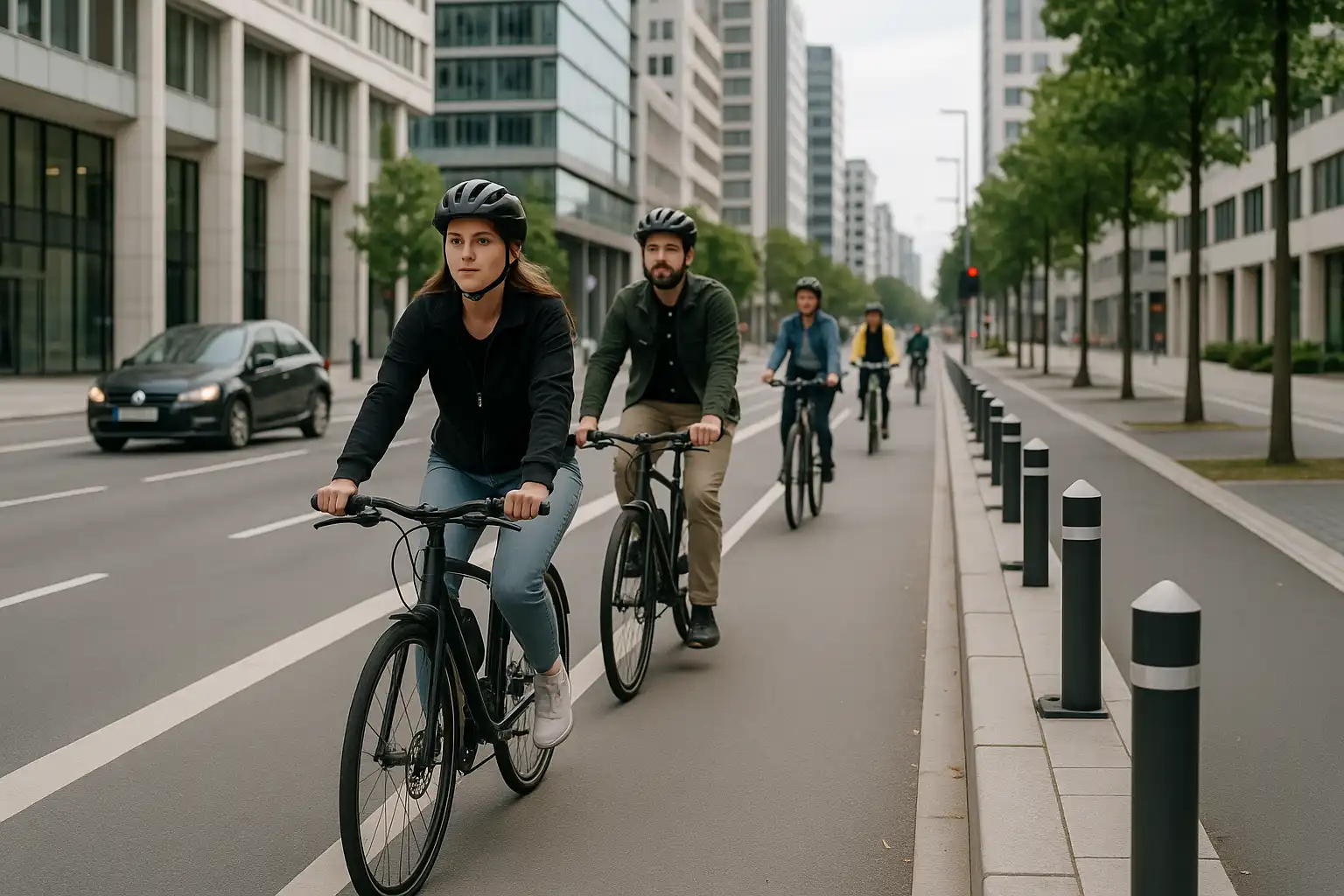Urban cycling is experiencing a renaissance in 2025, driven by innovative infrastructure solutions, smart technology integration, and a growing recognition of cycling’s role in sustainable city transportation. Cities worldwide are implementing comprehensive cycling strategies that go far beyond simply painting bike lanes on roads, creating integrated systems that make cycling safer, more convenient, and more appealing to residents of all ages and abilities.
The transformation of urban cycling infrastructure represents one of the most significant shifts in transportation planning in decades. Cities are moving away from car-centric design toward more balanced transportation systems that prioritize human-scale mobility, environmental sustainability, and public health. This shift is not just about accommodating existing cyclists—it’s about creating conditions that encourage more people to choose cycling as a primary mode of transportation.
## The Protected Infrastructure Revolution
The most visible change in urban cycling infrastructure is the widespread adoption of protected bike lanes. Unlike traditional painted bike lanes that offer little more than visual separation from traffic, protected bike lanes use physical barriers to create dedicated space for cyclists. These barriers can range from simple plastic bollards to sophisticated concrete barriers with integrated landscaping.
Protected bike lanes have proven dramatically more effective at encouraging cycling than traditional infrastructure. Studies consistently show that protected lanes can increase cycling rates by 50-200% compared to painted lanes or shared roadways. This increase isn’t just among experienced cyclists—protected infrastructure particularly appeals to potential cyclists who were previously deterred by safety concerns.
The design of protected bike lanes has become increasingly sophisticated, incorporating features like dedicated traffic signals, protected intersections, and integration with public transit systems. Many cities are now implementing “complete streets” designs that allocate space for pedestrians, cyclists, public transit, and vehicles in ways that prioritize safety and efficiency over vehicle speed.
The economic benefits of protected cycling infrastructure are becoming increasingly clear. While the initial investment can be substantial, protected bike lanes often cost significantly less than equivalent road capacity for vehicles. Additionally, the health, environmental, and economic benefits of increased cycling often provide positive returns on infrastructure investments within just a few years.
Cities are also discovering that protected cycling infrastructure can serve multiple purposes beyond transportation. Well-designed bike lanes often include green infrastructure elements like bioswales and urban forests that help manage stormwater, improve air quality, and enhance urban aesthetics.
## Smart City Integration: Technology Meets Cycling
The integration of smart technology into urban cycling infrastructure is transforming how cyclists navigate and interact with city systems. Smart traffic signals that detect approaching cyclists and adjust timing accordingly are becoming more common, reducing wait times and improving traffic flow for all road users.
Real-time information systems provide cyclists with data about route conditions, traffic levels, and even air quality. Digital displays at key intersections and along major cycling routes can alert cyclists to construction, weather conditions, or special events that might affect their journeys. Mobile apps integrate this information with GPS navigation to provide optimized routing that considers factors like elevation, traffic, and personal preferences.
Bike-sharing systems have become increasingly sophisticated, incorporating smart docking stations, GPS tracking, and mobile app integration. Modern bike-sharing systems can redistribute bikes automatically based on demand patterns, provide real-time availability information, and even offer different types of bikes for different use cases.
The integration of cycling infrastructure with broader smart city systems is creating new possibilities for urban mobility. Traffic management systems can now optimize signal timing for all modes of transportation, including cycling, while parking management systems can provide real-time information about bike parking availability.
Environmental monitoring systems integrated with cycling infrastructure provide valuable data about air quality, noise levels, and other environmental factors. This information helps city planners make informed decisions about infrastructure placement and design while providing cyclists with information to make healthier route choices.
## Bike-Sharing Evolution: The New Urban Mobility
Bike-sharing systems have evolved dramatically from their early implementations, becoming sophisticated transportation networks that serve millions of users worldwide. Modern bike-sharing systems offer multiple bike types, including traditional pedal bikes, electric bikes, and specialized cargo bikes for different transportation needs.
The technology behind bike-sharing has advanced significantly, with smart docking stations that can communicate with central management systems and mobile apps that provide seamless user experiences. GPS tracking allows for better fleet management and provides valuable data about usage patterns and popular routes.
Electric bike integration has been particularly transformative for bike-sharing systems. E-bikes make cycling accessible to a broader range of users and enable longer trips that might not be practical with traditional bikes. The ability to tackle hills and headwinds with electric assistance has expanded the effective range of bike-sharing systems and made them competitive with other transportation modes for longer urban trips.
Dockless bike-sharing systems have introduced new flexibility, allowing users to pick up and drop off bikes at any location within designated service areas. While these systems have faced challenges with bike distribution and maintenance, they’ve also demonstrated the demand for flexible, convenient bike access in urban areas.
The integration of bike-sharing with public transit systems is creating seamless multimodal transportation networks. Many cities now offer integrated payment systems that allow users to access bikes, buses, trains, and other transportation modes with a single account or payment method.
Corporate and institutional bike-sharing programs are also expanding, with employers, universities, and other organizations providing bike access for their communities. These programs often serve as feeders to larger public bike-sharing networks and help normalize cycling as a transportation option.
## Intersection Design: Where Safety Meets Innovation
Intersection design has become a critical focus area for urban cycling infrastructure, as intersections are where most cycling accidents occur. Traditional intersection designs that prioritize vehicle movement are being replaced with designs that consider the needs and safety of all road users.
Protected intersections use physical barriers and dedicated signal phases to separate cyclists from turning vehicles, dramatically reducing the risk of right-hook and left-hook collisions. These intersections often include dedicated cyclist waiting areas, clear sight lines, and signal timing that gives cyclists a head start before vehicles begin moving.
Roundabouts designed for cycling can provide safer and more efficient intersection crossings than traditional signalized intersections. Cycling-friendly roundabouts feature dedicated cycling lanes, appropriate speeds, and clear sight lines that allow all road users to see and react to each other safely.
The integration of smart technology into intersection design is enabling more responsive and adaptive traffic management. Sensors can detect approaching cyclists and adjust signal timing accordingly, while communication systems can provide real-time information to both cyclists and drivers about traffic conditions and signal timing.
Intersection design is also incorporating principles of universal design, ensuring that infrastructure works for cyclists of all ages and abilities. This includes considerations for cargo bikes, adaptive cycles, and cyclists who may need more time to navigate complex intersections.
## Parking and Storage Solutions
Secure bike parking has become a critical component of urban cycling infrastructure, as the lack of safe, convenient parking is often cited as a major barrier to cycling adoption. Cities are implementing comprehensive bike parking strategies that include both short-term and long-term parking solutions.
Automated bike parking systems are becoming more common in dense urban areas where space is at a premium. These systems can store bikes in compact, secure facilities and retrieve them quickly when needed. Some automated systems can store hundreds of bikes in the space traditionally required for just a few car parking spaces.
On-street bike parking is being integrated into streetscape design, with bike racks that complement urban aesthetics while providing secure attachment points. Many cities are also implementing bike corrals that convert car parking spaces into bike parking areas, often providing parking for 10-12 bikes in the space of a single car.
Workplace bike parking requirements are becoming more common in building codes and zoning regulations. Many cities now require new developments to provide secure bike parking for employees and visitors, often with requirements for shower and changing facilities to support bike commuting.
Residential bike parking is also receiving increased attention, with many cities requiring bike parking in new residential developments and providing grants or incentives for existing buildings to add bike storage facilities.
## Cargo Cycling: Reimagining Urban Freight
Cargo cycling is emerging as a significant component of urban transportation systems, offering sustainable alternatives to delivery trucks and personal vehicles for moving goods in dense urban areas. Electric cargo bikes can carry substantial loads while navigating through traffic and accessing areas that may be difficult for larger vehicles to reach.
Last-mile delivery services are increasingly adopting cargo bikes for package delivery, food delivery, and other urban logistics applications. These bikes can often complete deliveries faster than trucks in congested urban areas while producing zero emissions and requiring minimal parking space.
Family transportation is another growing application for cargo bikes, with many urban families using cargo bikes to transport children, groceries, and other daily necessities. Electric cargo bikes make it practical for families to replace car trips with cycling, even when carrying multiple children or heavy loads.
Infrastructure design is adapting to accommodate cargo bikes, with wider bike lanes, appropriate turning radii, and parking facilities designed for longer, heavier bikes. Some cities are also implementing cargo bike-specific infrastructure, such as dedicated loading zones and wider protected intersections.
The economic benefits of cargo cycling are becoming increasingly apparent, with businesses discovering that cargo bikes can often provide faster, more cost-effective delivery services than traditional vehicles. The reduced operating costs, parking requirements, and regulatory restrictions make cargo bikes attractive options for many urban businesses.
## Public Health and Environmental Benefits
The public health benefits of increased urban cycling are substantial and well-documented. Regular cycling provides cardiovascular exercise, helps maintain healthy weight, and can reduce the risk of numerous chronic diseases. At a population level, increased cycling rates can significantly reduce healthcare costs and improve overall community health.
Air quality improvements from reduced vehicle emissions benefit all urban residents, not just cyclists. Studies show that even modest increases in cycling rates can produce measurable improvements in urban air quality, particularly for pollutants like nitrogen oxides and particulate matter that are directly linked to vehicle emissions.
The mental health benefits of cycling are also significant, with regular cycling associated with reduced stress, improved mood, and better overall mental well-being. The opportunity for outdoor exercise and social interaction that cycling provides can be particularly valuable in dense urban environments.
Noise pollution reduction is another important benefit of increased cycling adoption. Bicycles produce virtually no noise compared to motor vehicles, and increased cycling rates can contribute to quieter, more pleasant urban environments.
The economic health benefits of cycling infrastructure often exceed the costs of implementation. Studies consistently show that the health benefits alone can justify cycling infrastructure investments, even before considering transportation, environmental, and economic development benefits.
## Economic Development and Urban Vitality
Cycling infrastructure has proven to be a powerful tool for economic development and urban revitalization. Well-designed cycling infrastructure can increase property values, attract businesses, and create more vibrant, walkable neighborhoods.
Retail businesses often benefit significantly from cycling infrastructure, as cyclists tend to make more frequent stops and purchases than drivers. Studies show that cyclists often spend more money per month at local businesses than drivers, even though individual trip spending may be lower.
Tourism benefits from cycling infrastructure are also substantial, with many cities discovering that cycling infrastructure attracts visitors and supports tourism-related businesses. Bike-friendly cities often market themselves as cycling destinations, attracting tourists who want to explore cities by bike.
The reduced infrastructure costs associated with cycling compared to automobile infrastructure can free up municipal resources for other priorities. The space efficiency of cycling infrastructure means that cities can often accommodate more people and economic activity in the same amount of space.
Employment opportunities in the cycling sector are growing rapidly, including jobs in bike manufacturing, retail, maintenance, and infrastructure construction. The growth of bike-sharing systems, delivery services, and cycling tourism has created new employment categories that didn’t exist just a few years ago.
## Challenges and Solutions
Despite the many benefits of urban cycling infrastructure, cities face significant challenges in implementation. Political resistance, funding constraints, and competing demands for limited street space can make it difficult to implement comprehensive cycling infrastructure.
Public engagement and education are crucial for successful cycling infrastructure implementation. Cities that invest in community outreach, education campaigns, and stakeholder engagement tend to have more successful cycling infrastructure projects and higher levels of public support.
Maintenance and operations of cycling infrastructure require ongoing attention and resources. Cities are developing specialized maintenance protocols and equipment for cycling infrastructure, recognizing that proper maintenance is essential for safety and user satisfaction.
Integration with existing transportation systems can be complex, requiring coordination between different agencies and consideration of multiple transportation modes. Successful cities often establish dedicated cycling coordinators or departments to manage these complex integration challenges.
Equity considerations are increasingly important in cycling infrastructure planning, with cities working to ensure that cycling infrastructure benefits all communities and doesn’t exacerbate existing transportation inequities.
## The Future of Urban Cycling
Looking ahead, urban cycling infrastructure will likely become even more sophisticated and integrated with broader urban systems. Advances in smart city technology, autonomous vehicles, and sustainable transportation will create new opportunities and challenges for cycling infrastructure.
The integration of cycling with autonomous vehicle systems could create new possibilities for shared road space and improved safety. Vehicle-to-infrastructure communication could allow autonomous vehicles to better detect and respond to cyclists, while smart infrastructure could provide real-time information to both cyclists and vehicles.
Climate change adaptation will become an increasingly important consideration in cycling infrastructure design. Infrastructure will need to be resilient to extreme weather events while also contributing to climate change mitigation through reduced emissions and urban heat island effects.
The continued growth of e-bikes and other forms of micro-mobility will require infrastructure adaptations to accommodate different speeds, weights, and usage patterns. Cities will need to develop policies and infrastructure that can accommodate the full spectrum of cycling and micro-mobility devices.
## Conclusion: Building Cycling Cities
The urban cycling revolution of 2025 represents a fundamental shift toward more sustainable, healthy, and equitable transportation systems. Cities that invest in comprehensive cycling infrastructure are discovering that the benefits extend far beyond transportation, contributing to public health, environmental quality, economic development, and overall urban livability.
The success of urban cycling infrastructure depends on comprehensive planning that considers the needs of all road users and integrates cycling into broader transportation and urban development strategies. Cities that approach cycling infrastructure as part of a holistic vision for urban mobility tend to achieve the best results and highest levels of public support.
As more cities implement successful cycling infrastructure and demonstrate its benefits, the momentum for urban cycling will likely continue to grow. The combination of proven benefits, advancing technology, and growing public support creates favorable conditions for continued expansion of urban cycling infrastructure.
For individuals, the growth of urban cycling infrastructure creates new opportunities for sustainable, healthy, and enjoyable transportation. Whether commuting to work, running errands, or exploring the city, cycling infrastructure makes it easier and safer to choose cycling as a primary mode of urban transportation.




